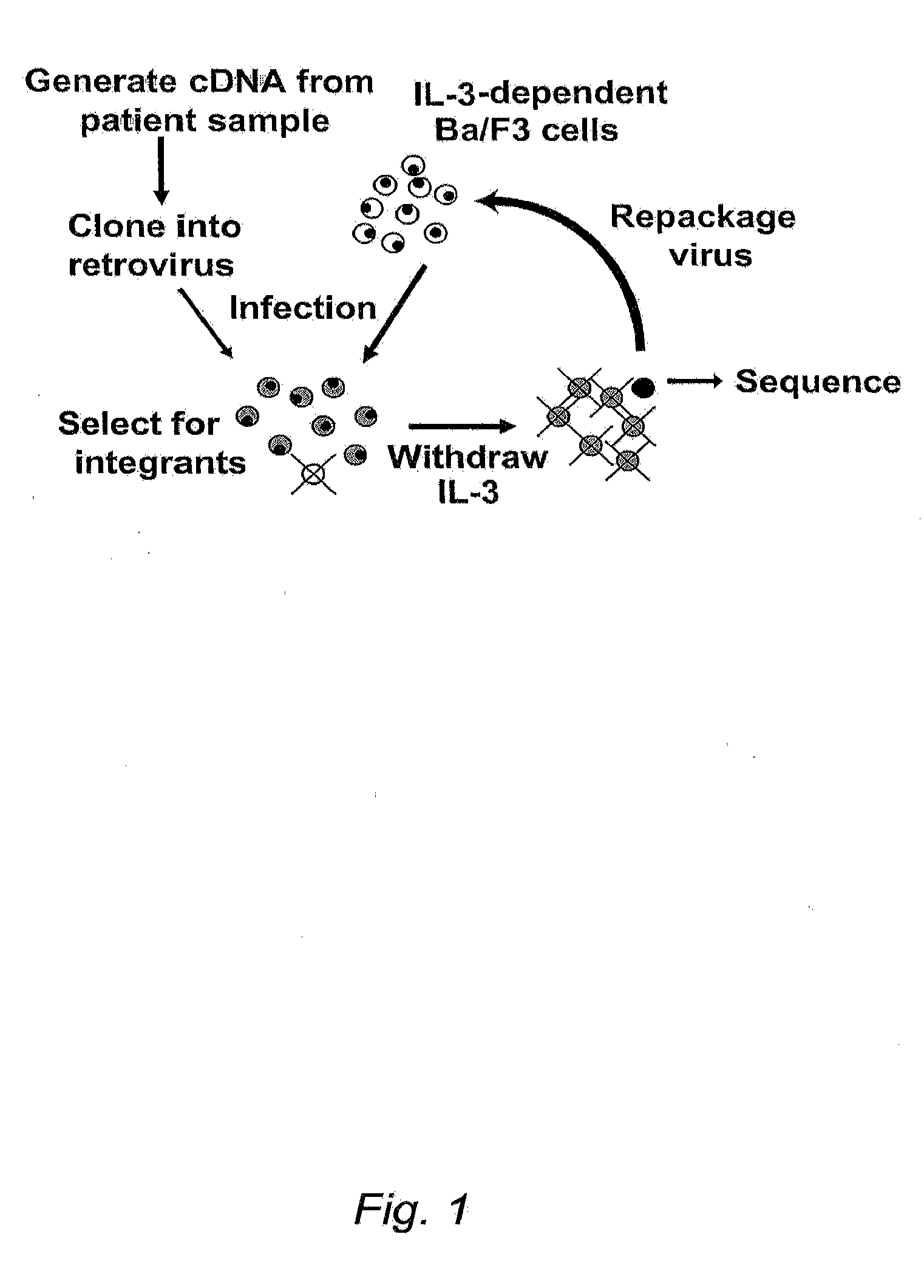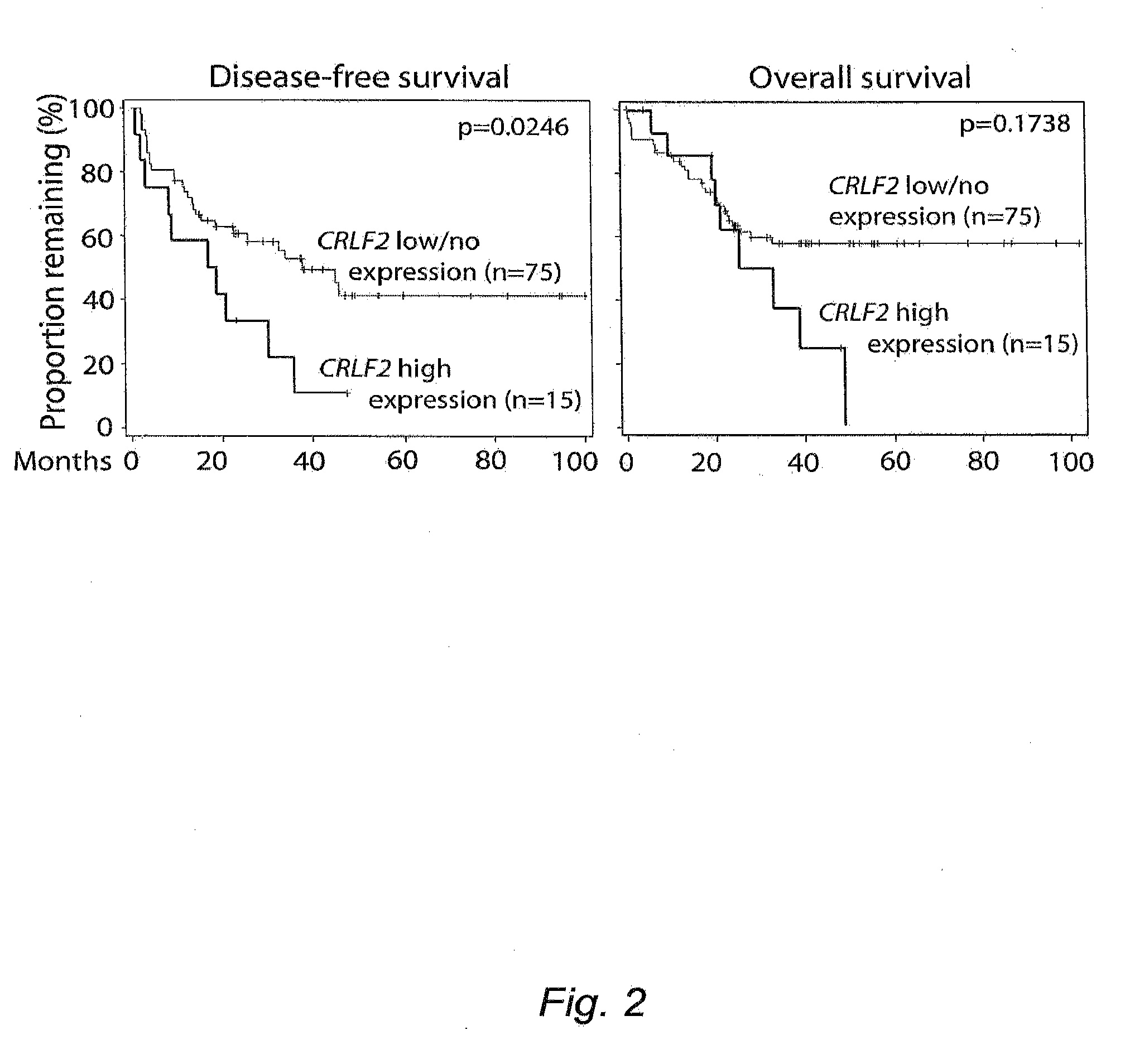Crlf2 in precursor b-cell acute lymphoblastic leukemia
a precursor b-cell and acute lymphoblastic leukemia technology, applied in the direction of immunoglobulins, peptides, drugs, etc., can solve the problem that one-third of b-all lacks characteristic rearrangements
- Summary
- Abstract
- Description
- Claims
- Application Information
AI Technical Summary
Benefits of technology
Problems solved by technology
Method used
Image
Examples
example 1
CRLF2 is a Gain-of-Function Oncoprotein in Poor Prognosis B-All
[0143]CRLF2 was identified in a functional screen for leukemia-derived cDNA that activate tyrosine kinase signaling (FIG. 1). In this screen, the murine IL-3 dependent cell line BaF3 were infected with retroviral cDNA libraries constructed from bone marrow aspirates involved with more than 80% tumor. Clones that survive IL3 withdrawal invariably harbor tumor-derived cDNAs that obviate the requirement for IL3. After infection with a cDNA library constructed from a B-ALL specimen with 46, XY karyotype, IL3-independent clones were identified that contained a mutated, full length cDNA transcript of CRLF2.
[0144]A combination of quantitative (q)RT-PCR, immunohistochemistry (IHC) and gene expression profiling (GEP) were used to assay CRLF2 expression in adult B-ALL samples from Dana-Farber Cancer Institute (DFCI; n=97) and Gruppo Malattie Ematologiche dell'Adulto (GIMEMA; n=157) cohorts. Cases with CRLF2 overexpression were cle...
example 2
CRLF2 Overexpression in Pediatric B-ALL
[0146]To determine the frequency of CRLF2 overexpression in pediatric B-ALL, the Gene Expression Omnibus (GEO; http: / / www.ncbi.nlm.nih.gov / geo / ) database for B-ALL samples assayed on the Affymetrix U133 platform were reviewed. Affymetrix HG-U133A and HG-U133Aplus2 arrays contain a single probe set (208303_s_at) that targets the CRLF2 transcript (both complete and partial coding sequence, as well as expression sequence tags).
[0147]Nine databases (Table 2) with a total of 1,253 pediatric ALL cases were identified. Among the 3 databases that included only high-risk patients, 52 (14.8%) of 351 B-ALL that lacked characteristic rearrangements had CRLF2 overexpression compared with 0 (0.0%) of the remaining 130 B-ALLs (p−4). This may underestimate the frequency of CRLF2 overexpression in the cohort without characteristic rearrangements, as some databases did not distinguish patients based on karyotype, so patients with characteristic rearrangements we...
example 3
CRLF2 in Other Common Lymphoid Malignancies
[0149]In order to determine whether CRLF2 is overexpressed in other lymphoid malignancies, a cross-section of chronic lymphocytic leukemia (CLL) specimens, based on karyotype, IgVH somatic hypermutation, ZAP-70 and CD38 expression, CLL family history, and clinical features were selected. All thirty specimens had no detectable CRLF2 mRNA. A review of gene expression profile data from GEO dataset GSE6477 (n=162) failed to identify significant CRLF2 expression in normal plasma cells, monoclonal gammopathy of undetermined significance, smoldering multiple myeloma (MM), newly diagnosed MM or relapsed MM. Low or undetectable CRLF2 expression was also confirmed in a panel of T-cell ALL (n=22) and other (n=14) cell lines.
PUM
| Property | Measurement | Unit |
|---|---|---|
| nucleic acid | aaaaa | aaaaa |
| concentrations | aaaaa | aaaaa |
| molecular mass | aaaaa | aaaaa |
Abstract
Description
Claims
Application Information
 Login to View More
Login to View More - R&D
- Intellectual Property
- Life Sciences
- Materials
- Tech Scout
- Unparalleled Data Quality
- Higher Quality Content
- 60% Fewer Hallucinations
Browse by: Latest US Patents, China's latest patents, Technical Efficacy Thesaurus, Application Domain, Technology Topic, Popular Technical Reports.
© 2025 PatSnap. All rights reserved.Legal|Privacy policy|Modern Slavery Act Transparency Statement|Sitemap|About US| Contact US: help@patsnap.com



